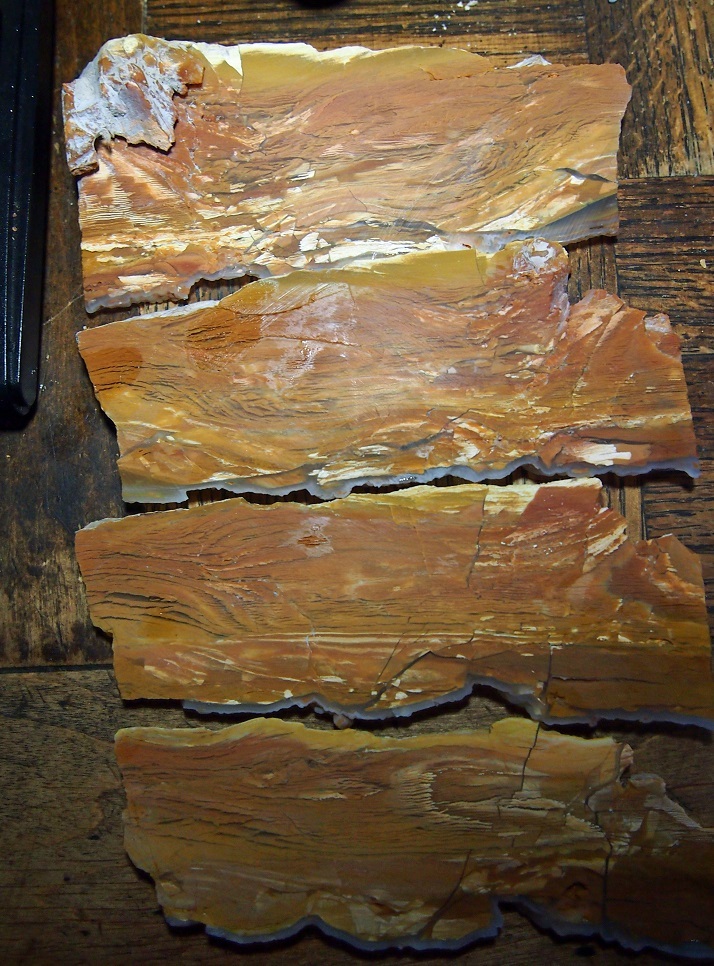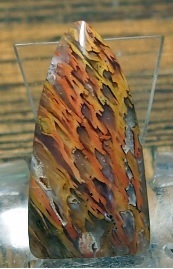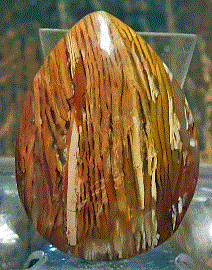|
|
Post by stardiamond on Jan 10, 2022 19:03:30 GMT -5
Fresh off the saw. about 5 inches.  |
|
brybry
Cave Dweller  Enter your message here...
Enter your message here...
Member since October 2021
Posts: 1,221
|
Post by brybry on Jan 10, 2022 19:15:08 GMT -5
Those got some pretty on them!
|
|
aGates
has rocks in the head
   Building a silver studio
Building a silver studio
Member since January 2021
Posts: 518
|
Post by aGates on Jan 10, 2022 20:14:57 GMT -5
oh yes please! that is so cool. could you elaborate on howardite?
|
|
|
|
Post by stardiamond on Jan 11, 2022 0:39:42 GMT -5
I've worked with Howardite for many years. It had a rattlesnake pattern. There are a lot of stories about where it came from. Sam Silverhawk was a supplier of rough and cabs some years ago. It is referred to as opalized chert. The supply has completely dried up. Not that long ago material was discovered and called new dig Howardite, Howardite, Red Howardite and Royal Flamingo. The new material is very similar to the original with fractures to work around and druse. On a slab of original there might be an area with the rattlesnake pattern and an area similar to the material I posted. My opinion is that original Howardite must have the rattlesnake pattern. Here are two cabs I made to illustrate the difference.   The new material is abundant and inexpensive. altamonbeadandsupply on Etsy has rough and slabs listed. I got the piece these slabs were cut from him. The piece was very solid and that is why I bought it. |
|
aGates
has rocks in the head
   Building a silver studio
Building a silver studio
Member since January 2021
Posts: 518
|
Post by aGates on Jan 11, 2022 8:56:52 GMT -5
thank you much. im just a thirty something pup trying to gain the knowledge from the seasoned ones. very cool rock but i can see why OG howardite is more saught after.
aGates.
|
|
|
|
Post by vegasjames on Jan 11, 2022 18:38:30 GMT -5
I've worked with Howardite for many years. It had a rattlesnake pattern. There are a lot of stories about where it came from. Sam Silverhawk was a supplier of rough and cabs some years ago. It is referred to as opalized chert. The supply has completely dried up. Not that long ago material was discovered and called new dig Howardite, Howardite, Red Howardite and Royal Flamingo. The new material is very similar to the original with fractures to work around and druse. On a slab of original there might be an area with the rattlesnake pattern and an area similar to the material I posted. My opinion is that original Howardite must have the rattlesnake pattern. Here are two cabs I made to illustrate the difference.   The new material is abundant and inexpensive. altamonbeadandsupply on Etsy has rough and slabs listed. I got the piece these slabs were cut from him. The piece was very solid and that is why I bought it. The material is supposed to be from Northern Nevada.
And wanted to point out that chert is a dehydration product of opal formed from biogenic silica sources. So, chert does not opalize although they can occur together as the opal is in the conversion stage. Just like opal can occur with other forms of chalcedony as the opal is converting in to those chalcedonies such as agate or jasper.
|
|
|
|
Post by stardiamond on Jan 11, 2022 19:34:41 GMT -5
I only grind rocks; not study them. This is the typical description when the material is listed:
Howardite, also known as Rattlesnake stone is rare form of opal silicated tuff, from northern Nevada. This material was completely dug out long ago, and what little there is to be had from collectors comes at a very steep premium.
|
|
|
|
Post by vegasjames on Jan 11, 2022 20:02:41 GMT -5
I only grind rocks; not study them. This is the typical description when the material is listed: Howardite, also known as Rattlesnake stone is rare form of opal silicated tuff, from northern Nevada. This material was completely dug out long ago, and what little there is to be had from collectors comes at a very steep premium. That makes a lot more sense. Tuff is quite different than chert. Again, chert is a dehydration product of opal derived from biogenic soruces. Tuff is formed from volcanic ash solidified in to stone. The silica from the volcanic ash can act as the silica source for the formatio of opal within the ash forming the stone. |
|
|
|
Post by stardiamond on Jan 11, 2022 20:11:59 GMT -5
I only grind rocks.
|
|
|
|
Post by stardiamond on Jan 16, 2022 16:30:04 GMT -5
I got an email for this and it looks I can get one nice cab from it.  ebay ebay |
|